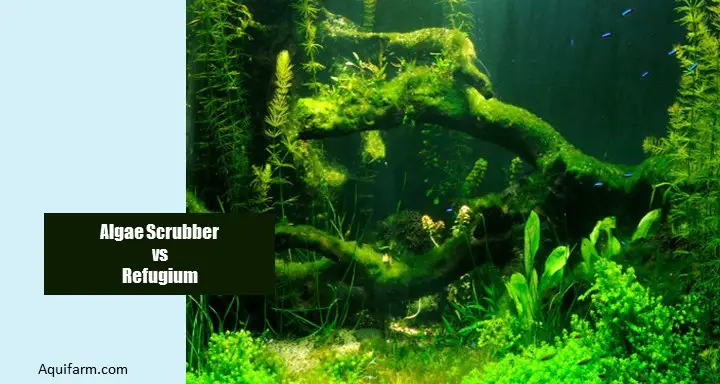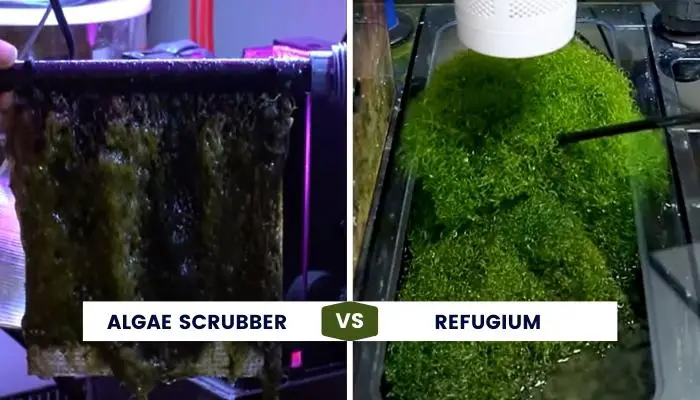
For the growth and biological filtration of your aquarium inhabitants, you always want a better option. Algae scrubber and refugium are great options to get an enthusiastic environment for your saltwater plant.
But you may have trouble choosing between algae scrubber and refugium.
So, which is the wiser choice- algae scrubber vs refugium?
A refugium grows macroalgae for nutrient management and copepods. Algae Scrubbers do both. The scrubber grows algae and copepods like crazy. Cleaning an algae scrubber often involves removing hundreds of amphipods and copepods. No equipment grows them better. This increases your sump’s flex space.
Which is best for an aquarium? This article settles the debate between algae scrubbers and refugium. Let’s read the whole article!
Algae Scrubber vs Refugium- Contrast in a Flash
First, let’s take a look at the two gadgets side by side to see how they stack up. We’ll be able to tell these two gadgets apart with the use of the table below-
| Features | Algae Scrubber | Refugium |
Function | Water filtration | House microalgae |
| Criteria | Need light | Needs specific LED light |
| Setup | Easy to set up | Hard to set up |
| Size | 6”*6” to 11.5* to 10.5” | 20% the size of the main tank |
| Maintenance | Hard to maintain | Easy to maintain |
| Price | $150 to $ 350 | 35$ to 50$ |
The table clearly shows the differences between refugium and algae scrubber are substantial.
Algae Scrubber vs Refugium- Thorough Discussion

We ought to be able to tell an algae scrubber from a refugium by this point. It’s time to get to the meat of the matter.
Feature
Water is filtered through an algae scrubber, which uses light to grow algae. Algae scrubber in the sump removes harmful compounds from the process. As a result, the ideal conditions for algae growth are created.
For aquarium hobbyists, algae scrubbers allow them to run their tanks utilizing natural filtration. The process, in fact, is done in the form of primary production, much like oceans and lakes.
Because algae like to grow in scrubbers rather than aquariums, the scrubbers assist in keeping algae contained. This device is basic, but it gets the job done!
Whereas, a refugium reduces nitrate and phosphate in aquarium water and provides natural food for aquarium residents. It is a chamber where macro-algae can grow and extract nitrates and phosphate from aquarium water.
Your aquarium animals will have a great food source in the form of copepods. Which you may encourage to proliferate in your aquarium.
Function
There are two types of algae scrubber- water flow scrubber and upflow scrubber. In the water flow scrubber, water is injected into the scrubber’s top and falls over a rough screen. A drainage system removes the water from the scrubber, and gravity returns it to your tank.
Air is used in the upflow. Filling the cavity is done by pumping in water and air at its base. After that, the algae develops on specially designed capture materials. From which it is possible to extract the algae.
On the contrary, refugium can house copepods and other isopods. A free, high-nutrient food source for your fish. Copepods are drawn into the display tank by the return pump.
Some fish, like the blue mandarin dragonet, solely consume these pods while adjusting to aquarium life. Hang-on or in-tank refugium like the CPR AquaFuge can be used instead of a sump system.
The way a refugium is connected to your aquarium can vary greatly. The simplest solution is to buy a sump system that already includes a refugium space.
Alternatively, a second distant chamber can be used. Although this will necessitate more plumbing and storage space.
Application
Algae scrubbers have a variety of applications. Algae scrubbers, when properly set up, may remove nitrate and phosphate to concentrations. Home test kits can detect too low pH levels.
You get a fresh start every week, and all of the tank’s inorganic nutrients are tossed away. In a scrubber, detritus cannot build up as it can in a refugium.
Algae turf scrubber reduces the frequency of nighttime PH fluctuations. It prevents the discharge of contaminated water by removing metals such as iron and copper.
You can tell whether something else is amiss in the tank by looking at the rate of growth.
Alternatively, there are numerous uses for a refugium. It provides your aquarium residents with natural food sources like phytoplankton and zooplankton.
Refugiums reduce water fluctuations by naturally filtering nitrate and phosphate levels. Also, it improves the quality of the water (especially oxygen level and pH)
Using a Refugium can assist keep the algae in your present tank under control. It reintroduces trace elements to the aquarium’s existing water.
Refugium is considered a temporary acclimatisation tank for new arrivals. It aids fish immune systems as macroalgae may emit chemicals that increase fish immunity.
Which Is the Best Choice?
A refugium is frequently used to raise copepods and macroalgae to manage nutrient levels. Actually, an algae scrubber excels at both. Within the scrubber’s mesh, copepods proliferate and algae grow like crazy.
Cleaning an algae scrubber frequently results in the removal of hundreds of amphipods and copepods. No other piece of machinery is more effective at growing them. As a result, you can perform more tasks in your sump’s flex space.
Algae scrubbers boost algae growth like tomatoes! Feeding growth is also important and interesting to consider. Algae is the only filter that can be fed to your animals. You can also make DIY algae scrubbers at home!
Though algae scrubber is more pricey than refugium. But proper maintenance of an algae scrubber can ensure its longevity. So, we think it’s a better option!
But if you’re finding a budget-friendly water filtration system, then you wanna buy a refugium. The choice is up to you and you’re totally welcome!
FAQs
How Long Should I Leave My Algae Scrubber Running For Optimal Results?
A total of 18 hours. To prevent “burn-out,” never leave your lights on 24 hours a day. Algae require a break from activity. Algae are amazing in that they conduct most of their filtering in the dark. They only become bigger in the light.
Is It Possible That The Addition Of A Refugium Can Improve PH Levels?
For the most part, macroalgae are kept in a refugium. Carbon dioxide (CO2), nitrates, and phosphates are all absorbed by the macro as it expands. As a result, not only will the pH be raised, but nutrients will be removed as well.
What Is The Purpose Of A Saltwater Aquarium Refugium?
A saltwater refugium is a distinct location where macroalgae and microfauna like copepods can flourish. A saltwater refugium lets macroalgae develop without being eaten or overrunning your primary reef tank.
Conclusion
To wrap things up, here we are. We hope that now you have no trouble choosing between Algae Scrubber vs Refugium.
If you’re shopping for a new gadget, be sure you pick one that fits your needs. This is a great approach to help maintain the health of the species in your aquarium!
Thank you for reading; we hope it was helpful. Next time, we’ll see you!
- Top 15 Freshwater Aquarium Plant Ideas for a Lush, Green Tank - November 9, 2024
- Top 13 Freshwater Aquarium Layout Ideas for a Beautifully Organized Tank - November 9, 2024
- 14 Stunning Rustic Freshwater Aquarium Ideas for a Tranquil Environment - November 9, 2024
